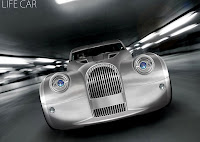Morgan Life Car Concept, 2008
The green car that will deliver on performance and looks as well as emission reduction
Now less than 12 months from reality, the British consortium involved in the project, which includes the legendary sports car manufacturer Morgan, QinetiQ, Cranfield and Oxford universities, BOC and OSCar, is on target to unveil the completed and running prototype at the 2008 Geneva show.
The new vehicle, known as Morgan LIFECar ultra quiet, and its exhaust system will produce only water vapour thanks to its fuel cell converting hydrogen into electricity.
"The real challenge is to design and build a car that is fun to drive - a proper sports car" quoted Charles Morgan, the strategy director for the Morgan Motor Company. "The use of ultra capacitors to store the surplus energy and then use this for acceleration and braking does promise a dynamic ride, especially when combined with our ultra light chassis. The pairing of weight to a minimum is our strength, and allows a much smaller fuel cell than conventionally thought necessary. This gives energy and yet more weight savings"
Part funded by the Department for Trade and Industry (DTI), Morgan LIFECar has been a 2 ½ year project. The consortium hopes that the LIFECar will produce a combination of performance, range and fuel economy that should alter our view of motoring for the future.
The key to delivering this step change in energy efficiency lies in a combination of factors, including weight reduction and a different design approach. Costing a total of £1.9m, with a mix of industry and DTI funding, the two and a half year project has been broken down into the following areas of responsibility.
The technical background
The car's fuel cell system operates by electrochemically combining on-board hydrogen with oxygen taken from the air outside.
Though in most respects fuel cells are more like engines than batteries, to the extent that they generate energy from fuel in a tank rather than store energy, like batteries, they use electrodes (solid electrical conductors) with an electrolyte (an electrically conductive medium). When the hydrogen molecules come into contact with the negative electrodes, the molecules split into protons and electrons.
The protons are then carried across the proton exchange membrane to the positive electrode of the fuel cell whilst the electrons travel around the external circuit as electricity. The molecules of the hydrogen and oxygen are combined chemically, with water as the only waste product.
The only emission from the QinetiQ fuel cell will be water vapour. The electric power generated by the fuel cells powers the electric motors and turns the wheels of the vehicle.
The green car that will deliver on performance and looks as well as emission reduction
Now less than 12 months from reality, the British consortium involved in the project, which includes the legendary sports car manufacturer Morgan, QinetiQ, Cranfield and Oxford universities, BOC and OSCar, is on target to unveil the completed and running prototype at the 2008 Geneva show.
The new vehicle, known as Morgan LIFECar ultra quiet, and its exhaust system will produce only water vapour thanks to its fuel cell converting hydrogen into electricity.
"The real challenge is to design and build a car that is fun to drive - a proper sports car" quoted Charles Morgan, the strategy director for the Morgan Motor Company. "The use of ultra capacitors to store the surplus energy and then use this for acceleration and braking does promise a dynamic ride, especially when combined with our ultra light chassis. The pairing of weight to a minimum is our strength, and allows a much smaller fuel cell than conventionally thought necessary. This gives energy and yet more weight savings"
Part funded by the Department for Trade and Industry (DTI), Morgan LIFECar has been a 2 ½ year project. The consortium hopes that the LIFECar will produce a combination of performance, range and fuel economy that should alter our view of motoring for the future.
The key to delivering this step change in energy efficiency lies in a combination of factors, including weight reduction and a different design approach. Costing a total of £1.9m, with a mix of industry and DTI funding, the two and a half year project has been broken down into the following areas of responsibility.
The technical background
The car's fuel cell system operates by electrochemically combining on-board hydrogen with oxygen taken from the air outside.
Though in most respects fuel cells are more like engines than batteries, to the extent that they generate energy from fuel in a tank rather than store energy, like batteries, they use electrodes (solid electrical conductors) with an electrolyte (an electrically conductive medium). When the hydrogen molecules come into contact with the negative electrodes, the molecules split into protons and electrons.
The protons are then carried across the proton exchange membrane to the positive electrode of the fuel cell whilst the electrons travel around the external circuit as electricity. The molecules of the hydrogen and oxygen are combined chemically, with water as the only waste product.
The only emission from the QinetiQ fuel cell will be water vapour. The electric power generated by the fuel cells powers the electric motors and turns the wheels of the vehicle.






0 comments:
Post a Comment